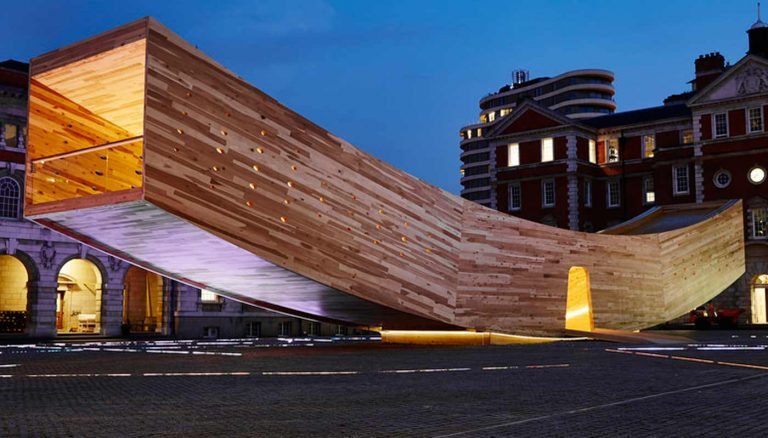Sustainable Design at LDF16: Our 7 Favourite Picks
The nice problem with LDF is that there's way too much to see in far too little time. As we explained in our guide for first time LDF visitors, the best way to experience it is to be discriminating, and plan around areas you're most interested in. And if you're interested in Sustainable Design at LDF16, you could have filled the whole week on just that topic.
Here are our 7 favourite picks of Sustainable Design at LDF16, from another glorious September week with London once more turned into a giant pop-up gallery.
Even though LDF16 is over, you can still discover and explore most of the work or thinking behind it, generally direct from the creators' websites or galleries.
1. Yinka Ilori's Upcycled Chair Workshop
Clerkenwell is one of the newer Design Districts. It hosts Design Unlimited, cross-discipline events that showcase products and talent from fashion, tech and design. Its stands for exactly what LDF aspires to achieve - in the words of the organisers:
[Design Unlimited] pushes boundaries & challenges conventions, not only showcasing exciting new products but also exploring the way we think about design in practice.
Highlights for 2016 included a set of chairs by Samuel Wilkinson crafted from steam-bent wood, and a space called the Vinyl Lounge, covered in a rainbow of geometric designs by graphic artist Camille Walala.
But the part we focus on is Yinka Illori's up-cycling workshop, set in the midst of his installation of fabulous chairs. Participants were free to bring their own chairs, or for a slightly higher entrance fee, were provided with a chair to use in the workshop. Probably the most hands-on example of sustainable design at LDF16, and definitely one of the most enjoyable!
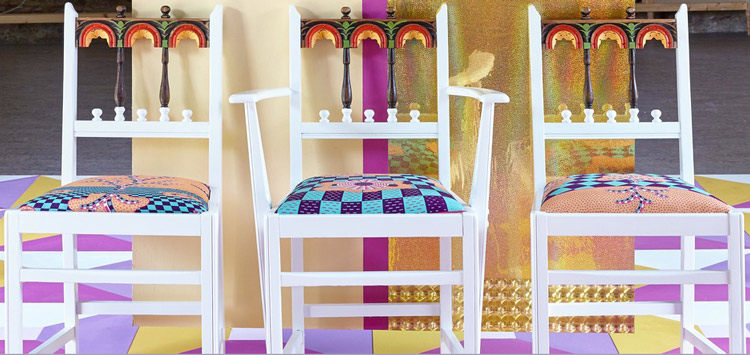
Upcycle Chairs Workshop at Clerkenwell (photo courtesy of LDF)
Yinko is known for up-cycling vintage furniture, with inspiration from his childhood in Africa, including traditional Nigerian parables. He believes those parables are as relevant today as ever they were, and looks to create pieces of furniture that in turn each tell a story.
"Ilori is passionately against the unnecessary waste he has seen in European and West African consumer cultures and this drives him to reuse discarded furniture and other found objects."
yinkailori.com
But as well as being driven by a serious issue, both he and his work are humorous, provocative and fun.
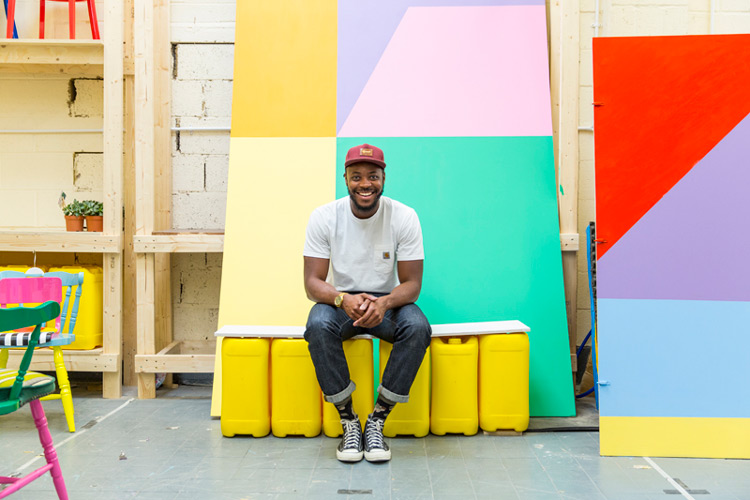
Yinka Ilori, lover of stories and hater of waste. (Photo from yinkaillori.com)
2. Ecotopia: ‘A Sustainable Vision For A Better Future’
Ecotopia is a fascinating installation in the Brompton Design District, created to celebrate the 500th anniversary Sir Thomas More's novel Utopia, and inspired by Ernest Callenbach’s 1975 novel Ecotopia.
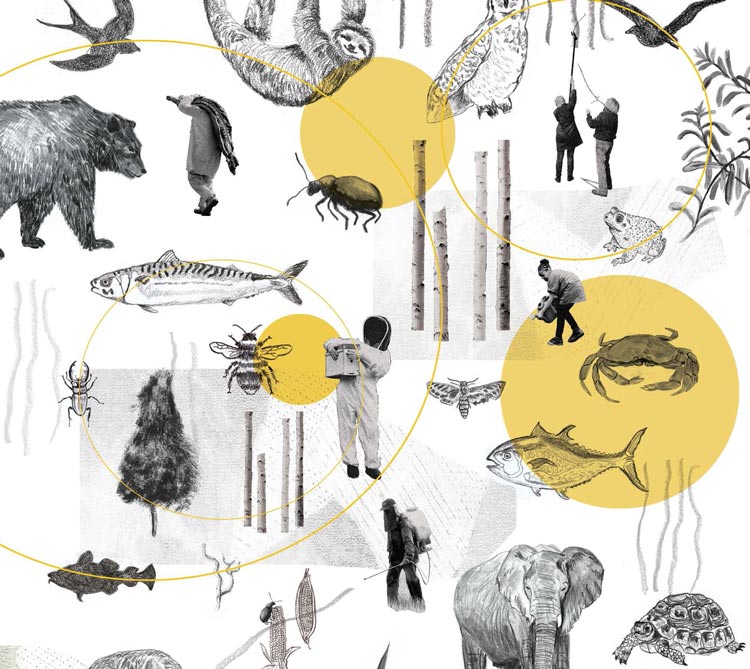
Ecotopia - highlight exhibit at Brompton Design District, LDF16 (photo from ecotopia2016.org)
Ecotopia is described as a multi-sensory installation, consisting of both physical and virtual pieces (via its website and social media). Its aim is to contribute to and stimulate the discussion of what we believe about our future, and our ability to influence it. In terms of sustainable design at LDF16, this is probably the most thought-provoking, and if you really engaged with it, you couldn't help leave with your mind broadened.
It explores so-called Utopian thinking, a slightly idealistic approach to the future of the planet and society, but connected with reality. Rather than simply re-hashing the thinking of the books that inspired it, Ectopia's creators focused on keeping it relevant to today, by showcasing the ideas of leading experts in climate change and sustainable solutions. This includes scientists, academics, designers and architects.
It's the work of a co-operative of creative talent: Aiden Barefoot (illustrator & printmaker), Nuno Coelho (lecturer in critical theory & curator) Toby Downham (illustrator), Luisa Kahlfeldt (designer), Melissa North (illustrator & printmaker), Caitlin Parks (illustrator & printmaker), Max Ryan (graphic designer & developer), James Sanderson (graphic designer), Will Verity (designer) and Roz Woodman (illustrator).
If you enjoy work that makes you think, especially about the bigger questions in life, this is something to get to know better and engage with.
3. ‘Transformation’: Indian Design Platform
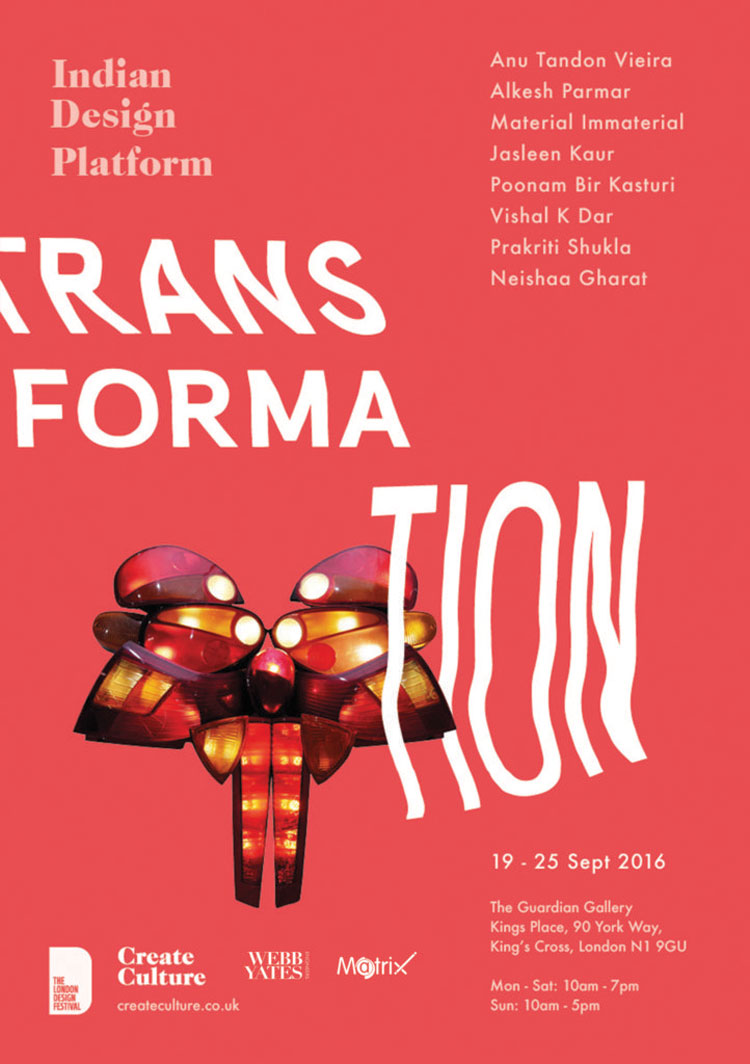
Poster for Transformation at LDF16, from the Create Culture website createculture.co.uk
Transformation is the second in an annual series of India-origin events at LDF, brought together by Arpna Gupta's "Create Culture" curation house. While last year was about introducing LDF to contemporary Indian designers, this year goes back to something India has been quietly embracing for centuries - sustainable design.
As the organisers explain, daily life in India involves an attitude to recycling and reuse that is at times taken to extremes, and there is a fascinating culture of adapting discarded and damaged materials for alternative uses.
In this exhibition, 6 Indian designers have used "humble, discarded materials" to create works of both functional and creative design, thus bringing a uniquely Indian twist to sustainable design at LDF16.
Despite the commonplace use of recycling and reuse in India, the rapid urbanisation of the country is leading to many new problems for society, one of which is the vast quantities of waste, much of it in newer materials compared to the understood ones of the past.
The exhibition covers a mix of old and new, demonstrating Indian-flavoured design thinking for recycling and re-use in practice.
Examples include furniture from recycled tyres using traditional weaving techniques; papier-mâché light fittings inspired by mushrooms and mosses; household objects from dismembered old washing machines; and a suit made from re-fashioned saris from the designer's mother and grandmother. Even the plinths for the displays were made from catering food cans from Indian cash and carry stores.
4. ‘Exploring Cork’ by Corque Design
Cork is one of the materials we get most excited about when it comes to sustainability. We keep coming across it in everything from construction to sustainable fashion, and are repeatedly surprised by what designers do with its unique combination of properties.
Led by Ana Mestre, Corque Design is a group of Portuguese designers embracing this, creating a design house single-minded about creating new applications and design solutions that utilise this super-material.
Their contribution to sustainable design at LDF16 was an exhibition at THECUBE London, in the heart of the Shoreditch Triangle.
What made the exhibition fascinating was how what could have been a conventional showcasing of work created from cork, managed to share the designers’ passion for the material.
For example, Cellula is a modular shelving system, but it’s inspired by the microscopic structure of the material, showing in a vivid way one aspect of why this material is so special.
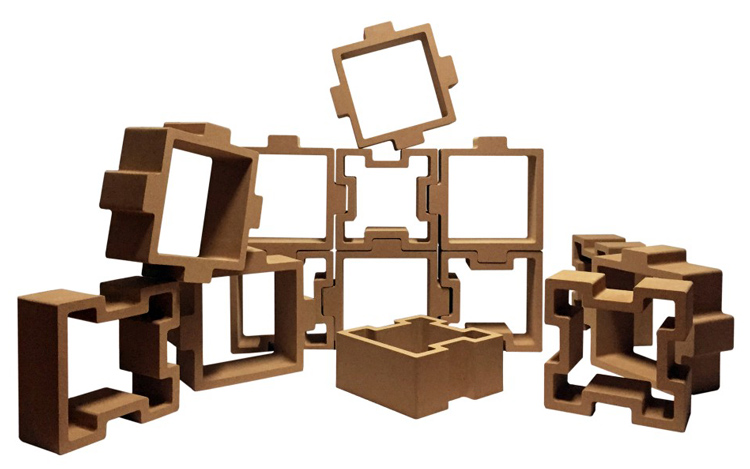
Cellula - creative use of cork (photo from www.corquedesign.com)
While the language the folks at Corque adopt might not be to your taste if you’re a fan of plain speaking, it’s well worth investigating - the combination of work, words and sheer passion communicates powerfully.
5. Bloomberg's ‘Waste Not Want It’
Bloomberg, the financial information, software and media company, has sustainability as one of the long-standing themes of its corporate philanthropy programme.
Their contribution to sustainable design at LDF16 was to launch the 5th series of Waste Not Want It, a programme of design challenges for designers to create innovative, functional installations using material recycled from Bloomberg’s waste.
This year, the work included lighting, wall decorations and meeting space furniture. The source material included cabling, keyboards, printer cartridges and wooden pallets.
Our favourite is probably Lara Bohnic's "Saturn", using holographic sheets from the inside of discarded screens. We might be showing our bias, but it's probably not a coincidence that she is a jewellery designer who started out studying industrial design.

Saturn - functional yet fascinating office furniture from recycled waste
We wholeheartedly agree with Lara's philosophy linking jewellery to other forms of design:
"I consider jewellery as an object for the body and furniture an object for the home or office. I like to make precious objects, whatever the scale."
Lara Bohnic
One interesting footnote to the programme is that many of the works are created “in dialogue” with Bloomberg employees, so that the designers can connect more strongly with the environment which is creating the waste, and what the materials were originally used for.
6. ‘The Circular Building’ at The Building Centre
The Circular Building is the work of a collaboration of organisations from the construction industry looking at how to reduce waste in the design and construction of buildings.
The team consists of Arup, The Built Environment Trust, Frener & Reifer and BAM. They start with the problem statement that half the waste created by the construction industry is not recycled, and propose that the “circular economy” is part of solving it.
"The construction industry produces three times more waste than UK households"
The Building Centre
The Circular Building is an exercise in exploring ways to design a building such that at the end of its life, all the materials and components used are re-used, re-manufactured or recycled.
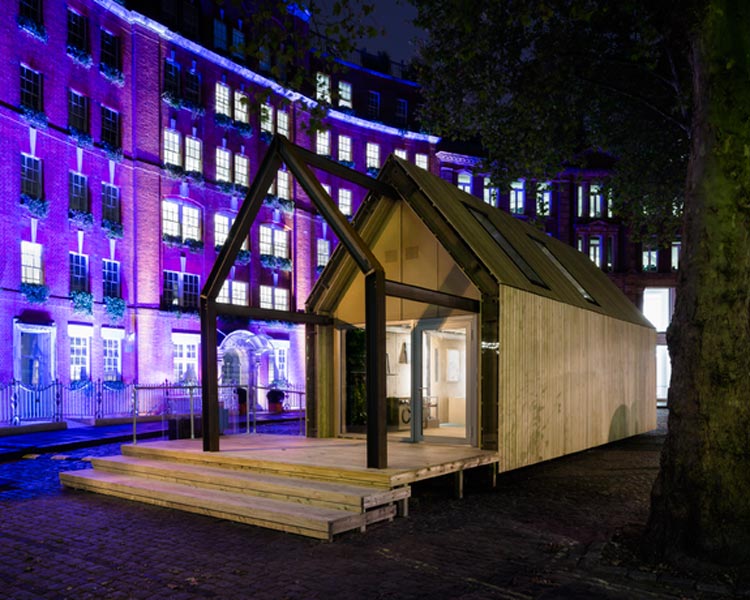
The Circular Building (Photo copyright Ben Blossom)
Arup describes the installation as “the most advanced reusable building yet”. It is a full scale prototype that demonstrates some principles involved, and tests others.
Some of the ideas involved include: selection of re-usable or recycled materials; maximizing off-site fabrication; using push-fit connections instead of adhesives; off-grid and low-voltage electrical systems. There is also extensive use of digital technology to support the ecosystem.
7. Tom Dixon's ‘Trellick’ Range with Goldfinger Factory
Designer Tom Dixon has teamed up with social enterprise Goldfinger Factory, an award-winning design, build and teaching platform. Dixon has put his name to a new line of furniture available to buy on the Goldfinger Factory crowdfunding page.
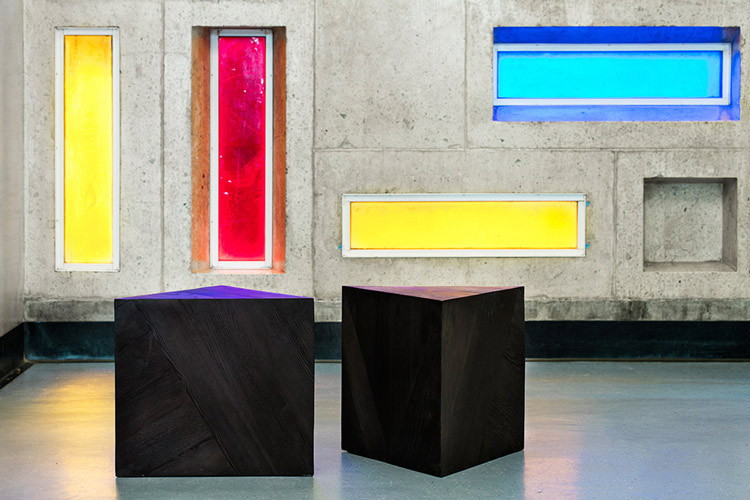
Goldfinger & Tom Dixon Trellick Stools (Photo from tomdixon.net)
Goldfinger Factory is all about engaging the community, providing long term training in carpentry and fabrication, both classical techniques and modern technology. It focuses on upcycling, creating bespoke furniture and interiors that help save materials from landfill.
It's located in Trellick Tower, and raising funds to expand into two new sites in Ladbroke Grove and Fulham, under a railway arch and in a vocational school, respectively.
We hope you've found this selection enjoyable reading, and it's inspired you to find out more about the designers we've featured. We found it an interesting approach to take a slice through LDF based on a design theme rather than a venue or district.
As well as the 7 picks, there were at least as many other events with a sustainable design theme which we didn't mention. We'll be mentioning those in future article, so if you want to discover new work, sign up below and we'll let you know when it's published.


